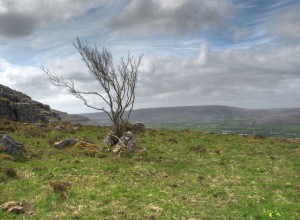
The Burren…it’s a Tolkein-esque name for an amazing area of western Ireland south of Galway and our area of interest for today, kids. Geologically, it’s a large area of limestone exposed during glacial activity of the Ice Age that had scraped away the top layers of sedimentary rock. As the eons passed, the weak acids in rainwater slowly etched away the at the exposed limestone, creating crevasses, caves, and underground rivers beneath a rugged topology and strangely-etched rocky landscape called “karst,” a term sure to spark immediate interest amongst cavers.
We were curious about this area, plus we know nothing about it outside of the few tourist brochures lying about. Therefore, we decided to take our first and only guided event during our Ireland trip. We found the flyer for John Connolly’s “Burren Wild Tours” in our B & B, so we scheduled a guided, 3-hour walk for this afternoon.
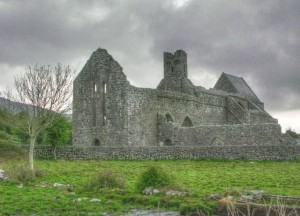
As he sold us our bus tickets, David, the host at the hostel in Doolin, took great pleasure in digging out his map of The Burren and pointing out the various trails in the area. He heard that we had scheduled a tour with John, and in the time-honored tradition of “you can’t get there from here,” he began pointing out all the ways we could walk the ten miles across the rugged hills to get back to Ballyvaughan. “Ah, don’t worry, it’s an easy walk,” he opined. “You’ll be back in plenty of time to catch the afternoon bus.” I’m glad that there are rugged indivuduals who can hike ten miles of harsh trails in two hours…but that’s not us.
Noel, the Bus Eireann driver, dropped us off in Bellharbor, and pointed up a road. “That road’ll get you to John’s. Make sure you visit the Abbey first.”
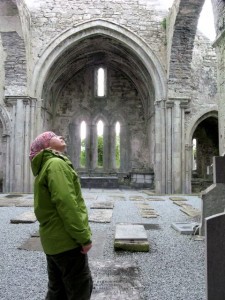
The Corcomroe Abbey lies at the end of a valley road, flanked by a pastoral landscape. For being a ruin, it’s in beautiful condition. The old graves are slowly being erased by centuries of exposure to the elements, so it’s worth a visit while it’s still standing. Over the years, people have buried their dead within the ruin itself, so the entire nave and apse is lined with old and new graves. Back in the 1400’s, in recognition of the unique area, the Cistercian monks named the abbey “Sancta Maria de Petra Fertilis,” or “Blessed Mary of the Fertile Rock.”
After slowly passing amongst the stones, we cut across a handy cow pasture, minus cows, and emerged on the road only a quarter-mile away from Burren Wild Tours, which is an old, family, working farm. We sat down by the garden and chatted with John’s father, who was kind enough to take a break from chores and talk with us about weather, the potato blight, and some of the strange geological features of this landscape. John came from the barn area and introduced himself, saying that we were waiting for two more people. It gave us more time to relax by the garden and watch clouds and birds float by.
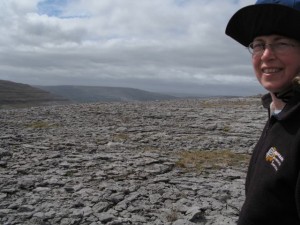
Karen and Kristen pulled in, right on time. After giving John €25 for each of us, we began our walk. John is an energetic guide, eager to share the landscape that has been his family’s farm for two and a half centuries. He brings his knowledge as an archaeologist and a scholar of history to give walkers on his tour a sense of time and place in history and geology.
From a distance, the Burren doesn’t seem like it could support life, but it is host to both warm climate and alpine plants. Brilliant blue gentian and alpine aven appear alongside orchids and primrose. As the limestone retains heat so well, the soil temperature never drops below 16C, even in winter.
As we walked, we carefully stepped over fissures and strangely-shaped drainage channels in the pale gray rock, which had formed over millenia.
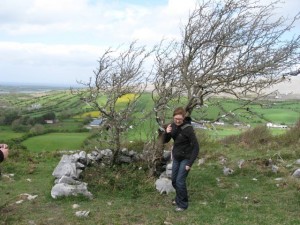
We came across a whitethorn tree, also known as a Fairy Tree, where generations of people would tie a little piece of cloth or ribbon, frequently blue, to the branches of the tree. Doing so would transfer whatever you were worried about to the tree. Right next to rhe Fairy Tree was a stand of hazelnut shrubs. There is a tradition that describes the hazelnut as a tree connected with the underworld, which John said was a way for ancient peoples to highlight the importance of certain plants and pass that knowledge on to the next generation. Kristen and Karen both tied on little strips to the whitethorn, and we headed further into the hills.
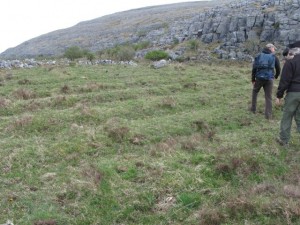
As we climbed up the jagged limestone, we paused as we entered a small, grassy plateau. John pointed out faint ridges in the earth, fading scars of desperate attempts to grow potatoes during the famine. One hundred and fifty years ago, the farmers had hoped that planting on the hillside would avoid the blight that was devastating the valleys below but sadly discovering that the blight was present even there.
We turned and looked across the valley towards the other Burren mountains at the odd, random stone walls meandering across the hillsides. These were “Famine Walls” built by Irish tenants at the command of the English landlords. The walls served no purpose, divided no parcels of land. The English figured that giving the starving citizens busy-work in exchange for a bit of soup or such would quell any potential unrest. John quietly added that looking at the walls is a solemn reminder of a tragic period in Irish history.
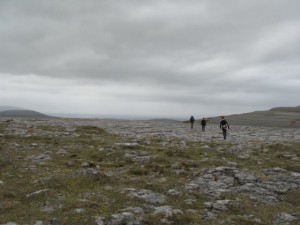
We finally crested the mountain and descended a little ways into an alpine valley, scoured by a chilly, strong northwest wind. Even here, the small, brilliant blue gentian and orchids popped up between the ridges of limestone.
We could see low mounds of stones on the opposite ridge, one at either end. Legend holds that two witches got into an argument that soon dissolved into a heated battle where they stood at either end of the ridge and hurled rocks at each other.
These mounds actually are pre-Christian burial mounds, holding the bones of ancient generations. We approached a mound that was nestled in the valley. This particular mound was torn apart by rabbit-hunters during the famine, although most of the mound still appeared intact. John climbed down the unearthed depression in the middle of the mound and reached deep beneath a stone. He emerged with two bones, one a first metatarsal and the other a fragment of a humeral head. They were sized right to be human, but whether they were human or animal will remain a mystery. Given that it was a burial mound holding many generations, and John’s professional archaeological opinion that they were indeed human, we believe the bones were human .
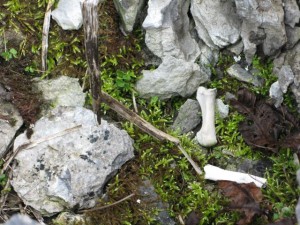
After placing the bones back in the mound, we climbed a short way up the opposite mountain. A sheltered cleft in the mountainside provided us opportunity to enjoy a rest out of the wind with tea from John’s volcano kettle, carrot cake made earlier by John’s mother, and some trail mix from Karen and Kristen from the Trader Joe’s in Baltimore.
We carefully picked our way down the mountainside while John seemingly floated over the limestone. We stopped at Saint Colman’s holy well, quite a beautiful spot, with an windswept ash tree bending over the tiny pool and stones. Lore says that washing your eyes with the water would alleviate eye problems.
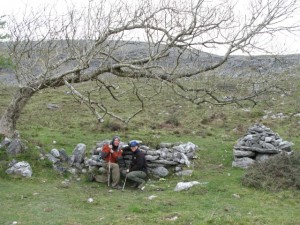
Holy wells are a pre-Christian, pagan tradition adopted by the church, much like Easter eggs or Christmas trees. The last generation that understands these traditions is dying out, leaving only the hippies and weird sorts to have any interest in these ancient ways.
We made our way down to the farm track and followed it back to John’s farm, where Karen and Kristen were kind enough to give us a lift back to Ballyvaughan where we caught the bus back to Doolin.
We normally avoid guided tours, as we find they limit our ability to spend time on our own truly learning about an area without being dragged off to a new place. John Connelly’s Burren Wild Tour is a glowing exception, and we heartily recommend it. It was one of the better side trips we made this entire holiday.
[findmespotmap start=”2010-04-28 11:15:00″ end=”2010-04-28 14:30:59″ id=”0-8062822″]
Comments
One response to “Days of Doolin — Day Five: The Burren”
Amazing story! I found it enthralling and very very interesting! The way you decribe things gives me a great picture in my head! Not as good as being there …but as good as I can get. Have fun!